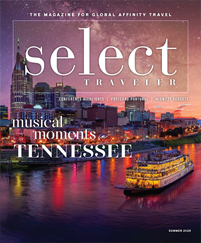Stories of race, family, culture, sacrifice and war are all part of an antebellum home visit. Our high-school classrooms could never inspire the goose bumps visitors experience when walking through these lavish homes where owners flaunted opulence and slaves toiled.
Virginia’s James River Plantations
Charles City, Virginia
Although many plantations along Virginia’s James River were once open to the public, only two remain. “We’ve saved the best for your bank groups,” said Richard Lewis, public relations manager for the Virginia Tourism Corporation.
Shirley Plantation, built in 1613, is the oldest plantation in the state and is still a working plantation. “This was home to the Carter family for 11 generations, and Robert E. Lee, whose mother was a Carter, was born here,” said Lewis.
It has been described as the most intact 18th-century estate in Virginia. Groups can tour the 1738 Great House, which contains original furnishings and a flying staircase, an architectural wonder that appears to have no visible means of support. Eight original outbuildings, including the smokehouse and the kitchen, and formal gardens are also part of the tour.
The Berkeley Plantation was the site of the first official Thanksgiving in 1619. The 1726 Georgian-style mansion filled with costumed guides lead groups through rooms of 18th-century antiques.
Berkeley guests are also treated to five terraces of restored boxwood and flower gardens overlooking the James River.
(800) 847-4882
www.virginia.org/groups
www.shirleyplantation.com
www.berkeleyplantation.com
Maury County, Tennessee
Maury County was a hotbed of activity during the Civil War for both sides, and history remains alive at this official Antebellum Homes Capital of Tennessee. The area offers four public antebellum homes for tours.
The James A. Polk Home was built in 1817 by Samuel Polk, father of the 11th president of the United States, James K. Polk. It was the first brick home in the area.
The Rippavilla Plantation includes the Federal-style home that was completed in 1855.
The Athenaeum, a Moorish Gothic structure, is unusual for antebellum buildings of the 1835 era. Although it was constructed for President Polk’s nephew, the building soon became the Athenaeum Rectory, part of a private school for girls. The house retains much of its original charm, including a chandelier made of seven metals, a French fountain on the front lawn and a 10-piece parlor set.
Elm Springs, a Greek-revival home built in 1838, narrowly escaped destruction during the Civil War. Today, headquarters for the Sons of Confederate Veterans, it continues to keep history alive.
(888) 852-1860
www.antebellum.com
Natchez, Mississippi
Fall and spring pilgrimage tours that include many antebellum homes not usually open to the public give Natchez more than 40 homes to explore.
“While many homes are open throughout the year, our pilgrimages are the times for bank groups to even see more,” said Marsha Colson with Natchez Pilgrimage Tours.
Each pilgrimage features about 25 homes. Just a few examples are Stanton Hall, built in 1851, featuring carved moldings and ironwork imported from Europe; Longwood, the largest octagonal house in the country; and House on Ellicott Hill, the site where Americans took possession of the area from the Spanish in 1797.
“Stanton Hall, really the dream of a Southern mansion, still includes original furnishings. Longwood, with five stories, has such incredible gingerbread work and represents the great wealth that was here and the changes that came about after the Civil War. Workers ran when they were called to join the troops, and the tools still lay in place,” said Colson.
(800) 647-6742
www.natchezpilgrimage.com
Charleston, South Carolina
Drayton Hall and Middleton Place, two antebellum plantations on the Ashley River, are the stars in this iconic Southern city.
Drayton Hall, the oldest surviving example of Georgian Palladian architecture in the country, has survived the American Revolution, the Civil War, the earthquake of 1886 and many hurricanes, including Hugo.
Construction began in 1738 by the first of seven generations of Draytons who would call the mansion home, along with seven generations of African Americans, some of whom were imported as slaves. The home is championed by architects today not only because it is a Colonial treasure, but also because it has been preserved, not restored. Visitors get a true glimpse of history, beginning in the days when the home was uses as a staging ground during the Revolutionary War.
Middleton Place, built in 1741, also miraculously survived the same traumas as Drayton Hall. It was home to four generations of Middletons, including a signer of the Declaration of Independence. Today, groups visit the house museum with its collection of original furnishings, 65 acres of gardens touted as America’s oldest landscaped gardens and stable yards.
(843) 853-8000
www.explorecharleston.com
www.draytonhall.org
www.middletonplace.org
Federal Hill Mansion
My Old Kentucky Home State Park
Bardstown, Kentucky
After sipping some bourbon in the Bourbon Capital of the World, it’s a must to visit the Georgian-style Federal Hill Mansion that inspired Stephen Foster in 1850 to write “My Old Kentucky Home.”
Home of three generations of the Rowan family, the mansion was started in 1794 and completed in 1818. The second generation raised 10 children there in the mid-19th century, and today the tour interprets that period.
“It is lavishly decorated in Victorian style, meaning there is color on color and pattern on pattern. The dining room, with palm tree wallpaper emulating the scenery the owner saw when he was an ambassador in Italy is especially spectacular,” said Ron Langden, curator.
A rare Ambler piano with mother-of-pearl keys is also a tour highlight.
The mansion is part of My Old Kentucky Home State Park, where groups can see an outdoor production of Stephen Foster: The Musical.
(502) 348-3502
www.parks.ky.gov









